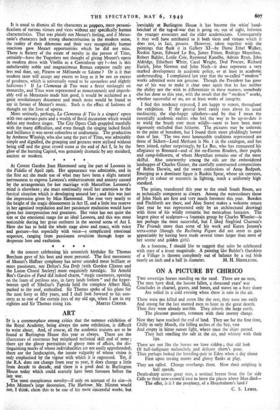ART
IT is a commonplace among critics that the summer exhibition of the Royal Academy, being always the same exhibition, is difficult to write about. And, of course, all the academic truisms are to be found at Burlington House this year as always. There are the illustrators of enormous but misplaced technical skill and of none ; there are the glossy portraitists of glossy men of affairs, the dis- tinguishing marks of whose individualities are not easily apprehended; there are the landscapists, the innate vulgarity of whose vision is only emphasised by the vigour with which it is expressed. Yet, if the R.A. does not change from year to year, it does change a little from decade to decade, and there is a good deal in Burlington House today which could scarcely have been foreseen before the late war.
The most conspicuous novelty—if only on account of its size—is John Minton's large decoration, The Harbour. Mr. Minton would not, I think, claim this to be one of his most successful works, but inevitably at Burlington House it has become the white hand- kerchief of the tug-of-war that is going on, out of sight, between the younger associates and the elder academicians. Consequently it may well have attributed to it both vices and virtues which it does not, in fact, possess. However, taken together with the paintings that flank it in Gallery XI—by Dame Ethel Walker, Ruskin Spear, Edward Le Bas, James Fitton, Rodrigo Moynihan, Robert Buhler, Leslie Cole, Raymond Kanelba, Adrian Ryan, John Aldridge, Ethelbert White, Carel Weight, Dod Procter, Richard Eurich, John Newton and John Nash—it does represent a very marked development in academic policy, or at least in academic understanding. I complained last year that the so-called " modern " works admitted were not genuine. Though the President has gone out of his way to make it clear once again that he has neither the ability nor the wish to differentiate in these matters, somebody else has done so this year, with the result that the " modern " works, whether successful or no, are at least works of integrity.
I find this tendency repeated, I am happy to report, throughout the exhibition. If the general level rarely rises above its usual mediocrity, the slap-happy splashers—and by that I mean the essentially academic realists who feel the way to be up-to-date is to wield the brush ever more wildly—seem to have been more rigorously excluded than hitherto. The pictures may be unheroic to the point of boredom, but I found them more ploddingly honest than of late. The two most honourable traditions represented are those of Sickert—Lord Methuen is No. t in the catalogue, and has been joined, rather surprisingly, by Le Bas, who has renounced his allegiance to Bonnard—and of the ex-Euston Roaders, their pupils and camp-followers, of whom Moynihan remains one of the most skilful. Also noteworthy among the oils are the embroidered landscapes of Charles Ginner, the carefully constructed compositions of Robin Darwin, and the sweet confections of Anne Redpath. Emerging as a dominant figure is Ruskin Spear, whose six canvases, pearly in colour or eccentric in lighting, reach a uniformly high standard.
The prints, transferred this year to the small South Room, are as technically competent as always. Among the watercolours those of John Nash are first and very much foremost this year. Bawden and Pitchforth are there, and Alan Sorrel makes a welcome return (last year he was represented only by an architectural drawing) with three of his wildly romantic but meticulous fantasies. The largest piece of sculpture—a fountain group by Charles Wheeler—is not perhaps the most successful, but I, liked Siegfried Charoux's The Friends more than some of his work and Karen Jonzen's terra-cottas (though the Reclining Figure did not seem to gain appreciably by having been made several times larger than most of her serene and golden girls).
As a footnote, I should like to suggest that sales be celebrated with stars of a lesser magnitude. A painting like Buhler's Outskirts of a Village is thrown completely out of balance by a red blob
nearly an inch and a half in diameter. M. H. MIDDLETON.






































 Previous page
Previous page